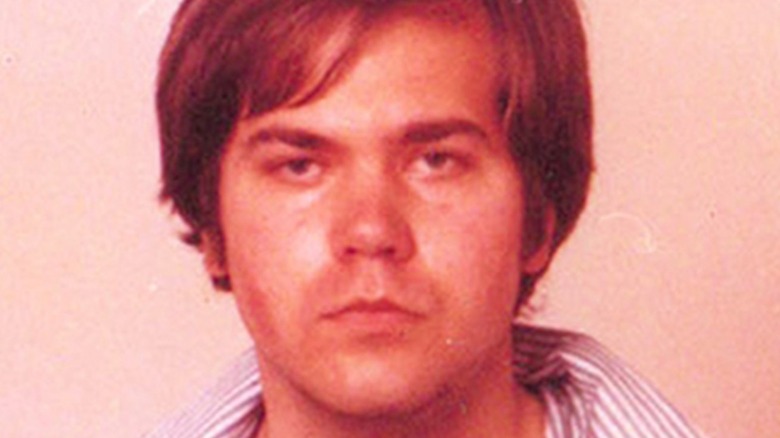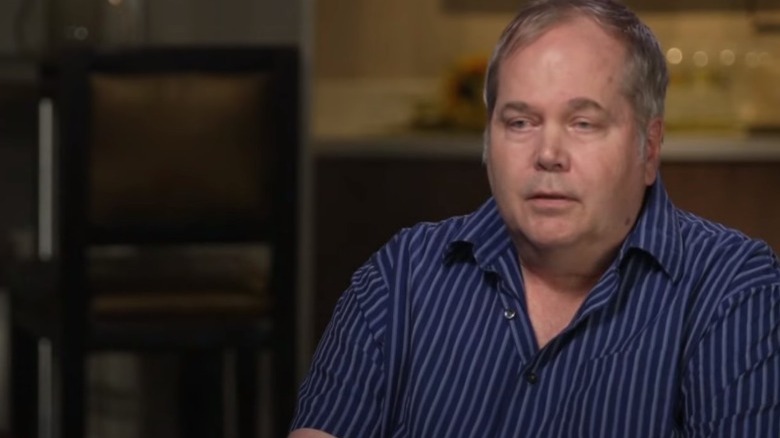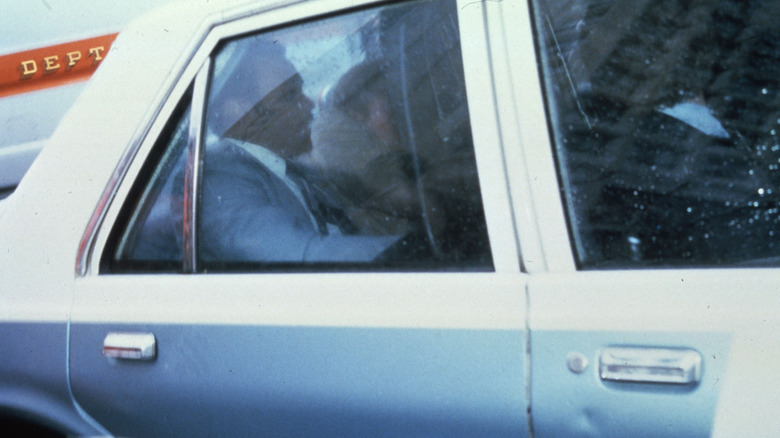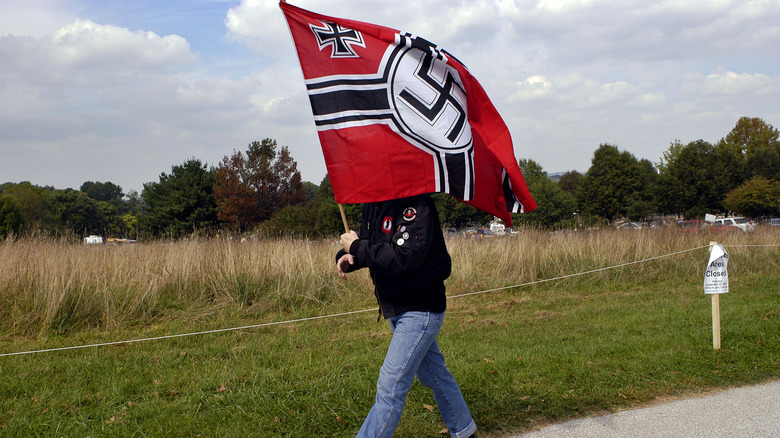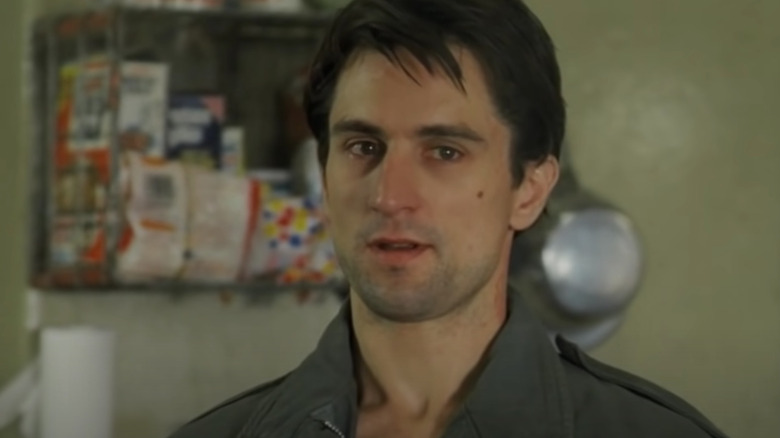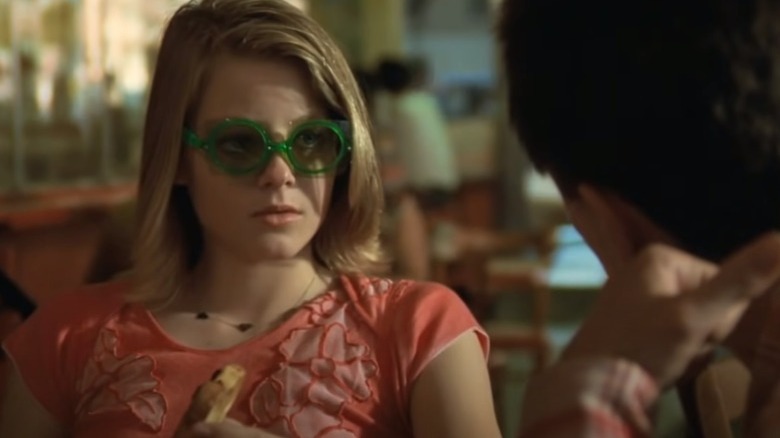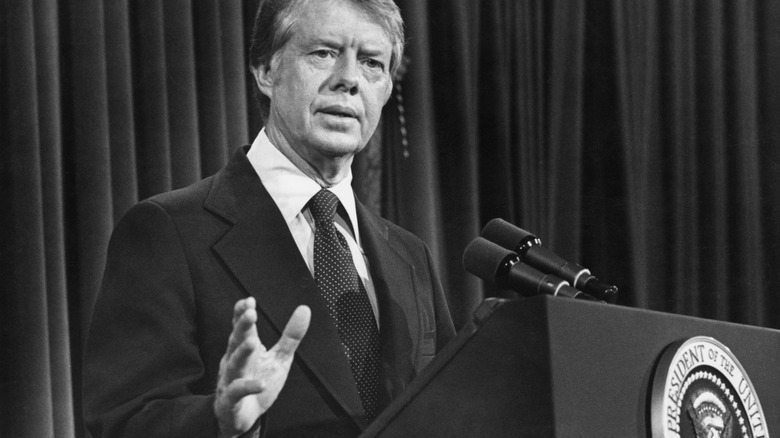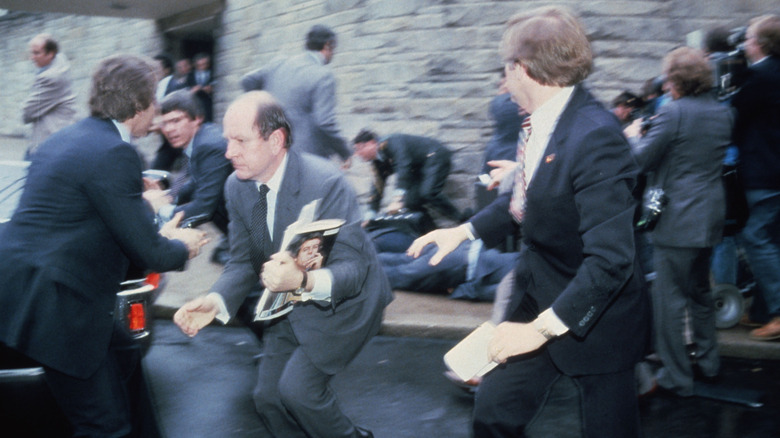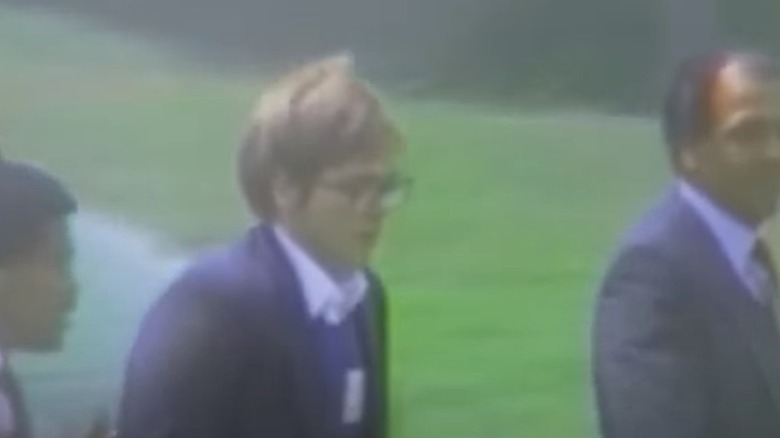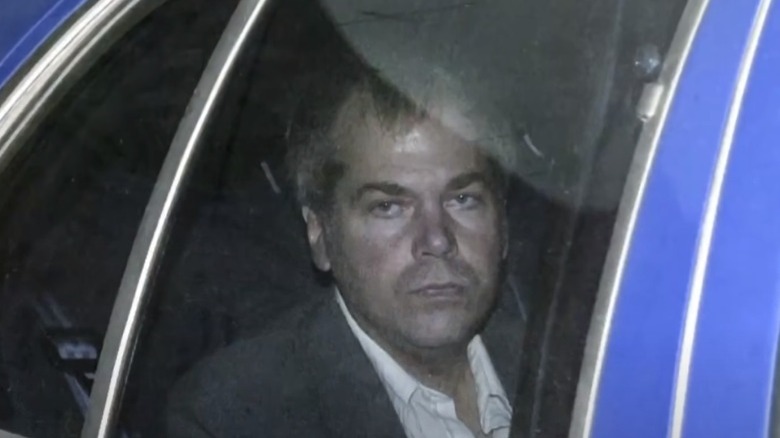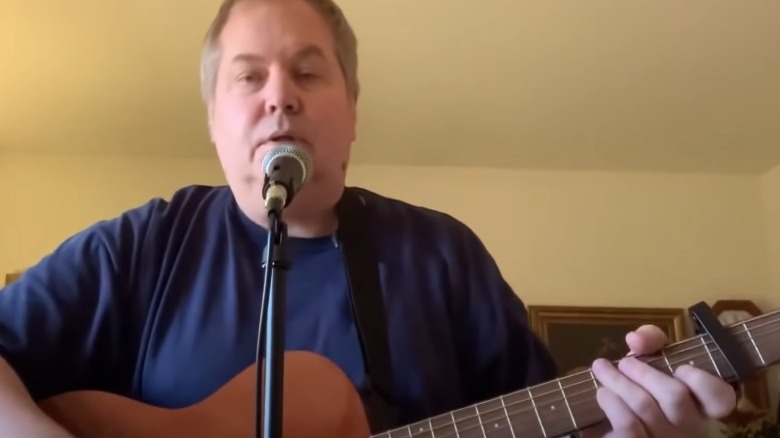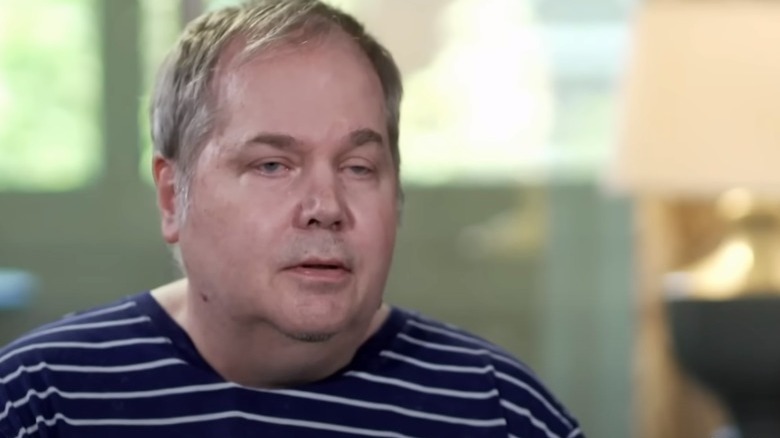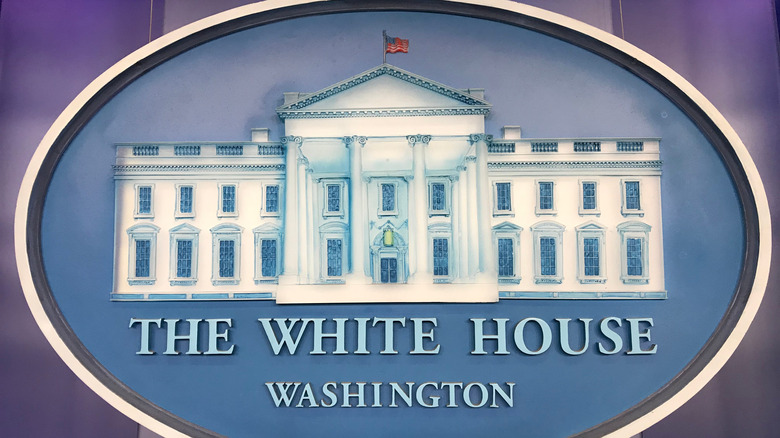The Real-Life Story Of John Hinckley Jr.
The policies of President Ronald Reagan would go on to help personify the 1980s, but his first term was very nearly cut short. He had been in office less than 100 days when, on March 30, 1981, John Hinckley Jr. walked up to him outside the Washington Hilton Hotel and shot him and three other people.
Secret Service agent Timothy McCarthy, police officer Thomas Delahanty, and White House press secretary James Brady were wounded, along with the president. Brady suffered severe permanent injuries after being shot in the face. (When Brady died in 2014, The New York Times reported, Virginia medical examiners ruled his death a homicide, as it was the result of the injuries he had sustained in the '81 attack.)
The would-be assassin was immediately restrained, and the president was rushed to a hospital. It was later reported that Reagan had suffered a collapsed lung and the bullet had missed his heart by the narrowest of margins (via History). The day after his surgery, he was signing documents, and on April 11 he returned to the White House.
Then the nation watched as a bizarre story unfolded around Hinckley's trial: Who exactly was he, and how did he decide to assassinate Reagan?
Hinckley had a picture-perfect childhood
One might expect that the childhood of a man who went on to gun down an American president had been filled with horrible events. But The New York Times reported that John Hinckley Jr.'s childhood was precisely the opposite.
Hinckley's father, John W. Hinckley, was the president-chairman of the Vanderbilt Energy Company, an oil-and-gas corporation that brought in revenues of around $4 million a year. (It's worth mentioning that's approximately $12 million a year today, after adjustment for inflation.) It's perhaps unsurprising, then, that John Jr. grew up in an upper-class Dallas neighborhood, attended one of the most elite schools there, and went on to enroll at Texas Tech. His father was a long-time conservative Republican and a supporter of Reagan; John Jr.'s older brother, Scott, was friends with Vice President George H.W. Bush's son Neil. Their father volunteered for a Christian relief group, and both parents were regular churchgoers. John Jr. had innate talents for playing guitar.
Two weeks after the assassination attempt, Time did an in-depth profile about the event — including a deep dive into Hinckley's early life. The article revealed that he was one of his elementary school's most promising basketball players, president of his homeroom, manager of the basketball team, and a member of a civic-affairs club and the Rodeo Club. At the same time, according to classmates and acquaintances, he managed to blend in as an unobtrusive young man.
By his late teens, people who knew Hinckley best observed personality changes
As John Hinckley Jr. started high school, people who knew him said he became a bit more detached, less involved with others — but he was by no means a loner. One classmate, Sally Bentley, explained (via Time), "He was well known because his sister was well known. John was mousy. His sister was friendly and cute and alive. I thought he was sour about that. John never did anything outstanding or memorable."
Classmates recalled that he got along with pretty much everyone, yet he didn't stand out. As a student at Texas Tech, he skipped activities, was a solid "B" student, and then, in 1976, decided he was going to take his guitar and head to Hollywood.
The New York Times interviewed Clarence Netherland, who was director of the energy company run by Hinckley's father. Netherland recalled the panic that the family felt when John Jr. simply disappeared for months. After spending some time in a seedier area of Los Angeles, he showed up near the family's home outside Denver. According to Netherland, he wasn't the same person: "Something happened to that boy in the last six to eight years' time to break him from the family tradition and the family lifestyle."
The American Nazi Party wanted nothing to do with him
In Time's examination of John Hinckley Jr.'s years at college, his professor of German history said Hinckley was a quiet student — but among the topics he chose to write about in his papers were Hitler's "Mein Kampf" and Auschwitz.
According to The New York Times, it was believed that Hinckley got serious about building Nazi connections in the months between dropping out of Texas Tech and reappearing at his parents' home. Michael C. Allen, the head of the National Socialist Party of America (also known as the Nazi Party of America) at the time, said that at a 1978 parade march in St. Louis, Hinckley was dressed in full regalia as a Nazi storm trooper.
Still, details of Hinckley's involvement in the party are sketchy and sometimes contradictory. The Texas Tech campus newspaper published a letter written by Hinckley in 1978 confirming that while he believed Nazis should be accorded freedom of speech, "no sensible person believes in the National Socialist Creed." But in 1979, the party declined to renew Hinckley's membership. "He kept talking about going out and shooting people and blowing things up," Allen explained to The New York Times. "When a guy comes to us advocating that, we make the assumption that he is either a nut or a Federal agent trying to entrap us. Either way, we don't want them."
Hinckley and Taxi Driver
"Taxi Driver" was released in 1976 during John Hinckley Jr.'s stint in the seedy side of LA, Time noted. As he drifted in California, he became obsessed, watching the film more than a dozen times.
But Hinckley was far from alone in his fixation on "Taxi Driver." LA Mag spoke with screenwriter Paul Schrader during an episode of the podcast "The Originals," and Schrader talked about a group he called "the 'Taxi Driver' kids." They were fans who became fascinated by Robert De Niro's character, Travis Bickle, and Schrader recalled an incident where one man — believing that the film was based on him — demanded to know how Schrader knew who he was.
He wasn't the only one to reach out. Schrader said that after hearing about the failed assassination attempt, he recognized the name: Hinckley had contacted him as well, in letters saying he wanted to be introduced to Jodie Foster, who co-starred in the film. Schrader said that he had confirmed that his secretary had thrown the letters away and swore her to secrecy, and that he had lied to federal investigators by saying he'd never had contact with Hinckley. (The story, however, also appeared in the issue of Time dated just a few days after Reagan returned to the White House.)
Hinckley's obsession with Jodie Foster
Jurors at John Hinckley Jr.'s trial, according to The Washington Post, watched "Taxi Driver" — screened by his lawyers. At the heart of Hinckley's motivations for trying to kill the president was his obsession with actor Jodie Foster, an assertion well documented throughout the trial, which included a statement from Foster saying that she'd never had a relationship with him.
In 1982, The New York Times ran a letter that Hinckley wrote in response to the paper's inquiries. He wrote that he saw the assassination attempt as giving his life meaning, and nothing that happened afterward would take that away. "I sacrificed myself and committed the ultimate crime in hopes of winning the heart of a girl," he added. "Yes, Jodie Foster knows who I am, just like the entire civilized world knows who I am. But does it matter now? I wanted Jodie's love, not eternal infamy."
Hinckley claimed that he had been fated to make an attempt on the president's life, adding that, in a way, he got what he wanted: He would always be tied to Foster, in the historical record and in her mind. "I am Napoleon and she is Josephine," he wrote. "I am Romeo and she is Juliet. I am John Hinckley Jr. and she is Jodie Foster. The world can't touch us. Society can't bring us down. Jodie can't ignore history."
Reagan wasn't Hinckley's first target
As months went by, John Hinckley Jr.'s letters to Jodie Foster went unanswered, and his attempts to contact her while she studied at Yale failed. He started down the path of thinking that only a massive gesture would get her attention. At first, his plan in that regard wasn't the killing of President Ronald Reagan — it was the killing of his predecessor, Jimmy Carter.
According to "Hunting the President," Hinckley started stalking Carter in September 1980. The then-president was on the campaign trail, and Hinckley — following the president's campaign route published in newspapers — first headed to a stop in Dayton, Ohio. He considered it a trial run, and when he easily got within arm's reach of the chief executive, he decided that his scheme was viable.
After Ohio, Hinckley followed Carter to Nashville — where he first backed out of pursuing the assassination attempt, and was then arrested for carrying guns on a plane. Hinckley later admitted that one of Carter's guards had made eye contact with him, and he hadn't been able to go through with it — but beyond that, when it began to seem Carter was going to lose the election, Hinckley decided that assassinating a failed candidate wouldn't be a glorious enough move for what he was trying to accomplish. Though he was identified alongside Carter and was carrying firearms, the Secret Service was never alerted.
Psychiatrists recommended Hinckley's parents abandon him
After John Hinckley Jr.'s attempt to kill the president, law enforcement officials attempted to reconstruct the events leading up to it. They included an arrest on October 9, 1980, said The New York Times. Hinckley had been traveling from Nashville to New York when airport security discovered three guns and some ammunition on his carry-on. He was arrested, the guns were confiscated, and he was released after paying a $50 fine. Four days later, at a Dallas pawn shop barely a mile from where John F. Kennedy was assassinated, he purchased the pistol that he used to shoot Reagan.
Hinckley's mother, JoAnn, testified (via The New York Times) that the family had been working with a psychiatrist to determine the best way to get Hinckley on a path to becoming a financially and socially independent adult. She explained that the mental-health professional had told them to give him $100, drop him at the Denver airport, and drive away — so that's what she did.
"I was frightened and I didn't know what to do," she remembered. "John got out of the car and I couldn't even look at him, and he said, 'Mom, I want to thank you for everything you've ever done for me.' I said, 'You're very welcome,' and I said it so coldly because I didn't want him to know what I was thinking, and then I drove off."
The next word that they received about their son was the news that he had tried to kill the president.
A shocking verdict of not guilty
Just days after President Ronald Reagan returned to the White House in 1981, the public read Time's blow-by-blow account of the assassination attempt. There were no doubts about whether John Hinckley Jr. had pulled the trigger, so when he went to trial, guilt wasn't being argued, but culpability was.
Hinckley, said NPR, was facing two outcomes: jail time or confinement to a psychiatric facility. His fate would depend on whether a jury thought he could be held accountable for his actions: The prosecution argued that he was completely responsible, but the defense contended that his psychiatric diagnosis — which included schizophrenia and depression — meant that he couldn't be found accountable.
Interestingly, a witness for the prosecution gave Hinckley a different diagnosis: According to Politico, forensic psychiatrist Park Dietz went on the witness stand and described "narcissistic and schizoid personality disorders and dysthymia, as well as exhibiting borderline and passive-aggressive behavior." Still, Dietz said, he was sane.
The jury didn't agree: Hinckley was found not guilty by reason of insanity. Instead of a jail sentence, he was sent to St. Elizabeth's Hospital, a Washington, D.C., psychiatric facility. He would remain there for the duration of his 35-year confinement.
Hinckley's hospital confinement
John Hinckley Jr. was sent from trial to a Washington, D.C., psychiatric facility called St. Elizabeth's Hospital, said Biography. What happened to him in the following decades, given that he had tried to kill a U.S. president, was surprising to many.
By the 1990s, Hinckley had quite a bit of freedom: He held down a clerical job, could move freely around the hospital grounds, and even had a long-term girlfriend. He also had an unlikely pen pal — he frequently exchanged letters with Ted Bundy before the serial killer's 1989 execution. In 1999, Hinckley was allowed to leave the hospital for short supervised visits with family. Although he had a small setback in 2000, he was given more and more freedom.
In 2016, the Washingtonian looked at Hinckley's life. For several years, his mother had been paying between $5,000 and $10,000 per month to send a limo to pick him up and transport him to her home in Williamsburg, Virginia, for 17-day visits. Sometimes, friends accompanied him — specifically, feral cats living on the grounds of the hospital that he fed and cared for.
Hinckley gave scores of interviews during his time there, often drawing attention to the fact that he didn't see himself as just a shooter. When Congresswoman Gabrielle Giffords was shot in 2011, he was reportedly horrified: "Wow, is that how people see me? ... I'm an artist, I'm a musician. Nobody knows that. They just see me as the guy who tried to kill Reagan."
A conditional release ... and a music career
John Hinckley Jr.'s life changed bit by bit. In 2016, he was given a conditional release from St. Elizabeth's. According to the Associated Press, Hinckley was permitted to move in with his mother in Williamsburg, Virginia full-time in September that year (his father passed away in 2008), and the family was already making plans for his mother's passing — John's older brother, Scott, also moved to Williamsburg.
Hinckley's freedom came with conditions. Two years later, Input reported, he had been given another freedom: He was now allowed to post and publish his music and artwork under his own name. (He had previously been publishing anonymously.)
Hinckley has found a serious fan for his work: Max Collins of the band Eve 6. Collins — who explained, "There's a throughline of hope to John's songs" — interviewed Hinckley, and they spoke about the past, present, and future. Hinckley said that he was getting to a better place, and was happy, but he added, "I did 35 years in a mental hospital. And let me tell you, that'll take a lot out of you to be an in-patient in a mental hospital for 35 years. It takes a lot out of you spiritually, physically, emotionally. So if you're hearing a tinge of sadness in the songs, it's probably from that."
Hinckley has apologized, and been granted an unconditional release
In 2022, John Hinckley Jr. officially became the first person to be released into freedom after attempting to kill a U.S. president. All of the restrictions and conditions attached to his freedom have been lifted, and shortly after the announcement, he sat down for interviews with several news networks, including ABC and CBS.
There, he apologized. "I have true remorse for what I did," he told CBS. "I know [the victims] probably can't forgive me now, but I just want them to know that I am sorry for what I did. ... I was not just a cold, calculating criminal in 1981. I'm glad I did not succeed."
Hinckley spoke candidly not only about his time at St. Elizabeth's — including his two suicide attempts — but said that he had changed: "Psychologically, that person is dead. I'm a completely different person in mind and spirit."
He added that he has no memories of the day he shot several people, including then-President Ronald Reagan — who, he noted, was a "nice man and a good president."
Plenty of people were not thrilled with his unconditional release. According to The Washington Post, the Reagan Foundation and Reagan's daughter Patti Davis both protested his free status. But court-appointed freedom doesn't guarantee a wide social acceptance: While Hinckley said he hopes to make a living with his music, four venues that had booked him quickly canceled his shows after receiving threats.
Hinckley announced he's starting his own political party
John Hinckley Jr. is up to something else these days: On November 9, 2022, he announced (via Twitter) that he was going to be starting his own political party, called the National Redemption Party. "We are for peace, love, racial equality, LGBTQ Rights, Abortion Rights, the Green New Deal," he wrote, adding, "We oppose the Mob that controls the music industry."
Yahoo! suggested that the part about the music industry revealed the truth of why Hinckley might be taking a run at politics. Just what his new political party means to do wasn't immediately clear.
Meanwhile, the impact his actions had on the American political and criminal landscapes is still felt. As NPR noted, the success of his insanity defense led to some states taking steps to change what an insanity defense looks like — by 1982, several states had begun addressing the removal of the option entirely.
Forever changed, too, was presidential security. CNN noted that all procedures as established in 1981 were correctly followed, but the attempt on Reagan's life led to a complete overhaul of Secret Service training, procedures, and particularly the process by which people are allowed to get close to a president.
